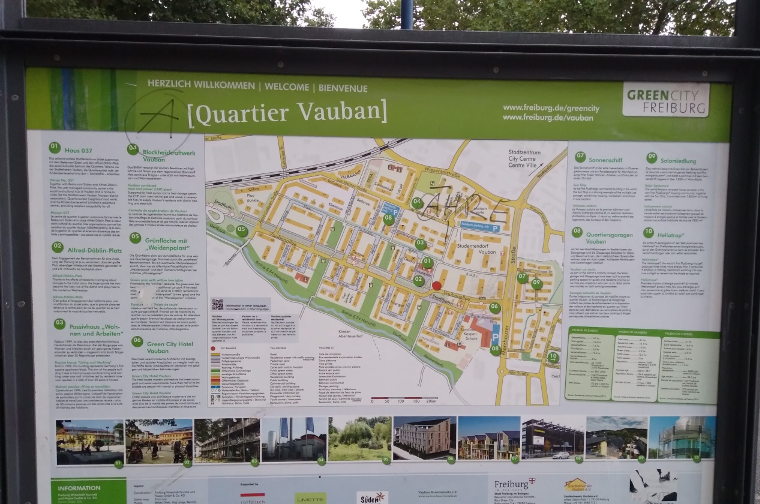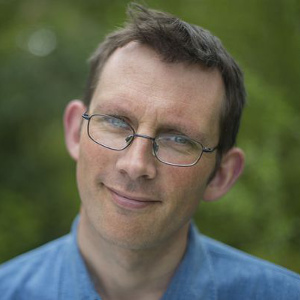During my talks, I often invite people to time travel in their imagination to a 2030 that’s not utopia, or dystopia, but rather is the result of our having done everything we could possibly have done in those intervening years. We do it because, as Walidah Imarisha puts it, “we can’t build what we can’t imagine”. Unless we cultivate longing for such a future, it will never happen. In spite of having done that exercise now over 100 times, the responses are pretty much always the same. “The birdsong is louder”. “There are far less cars”. “The air smells so much cleaner”. “The streets are full of kids playing”. “There is a strong sense of community”. It’s exciting then to be able to announce that this week I actually managed a spectacular feat of time travel to visit the future they dream of in that exercise, immersing myself in its magic and its deliciousness, with all my senses. It was incredible and life-affirming. And all I had to do was buy a train ticket to Freiburg in Germany.

The Vauban, a district of Freiburg which is home to about 3000 people, is one of the most ambitious and best-known car-free neighbourhoods in Europe. It was a French military barracks until 1991, and it covers 41 hectares of land. Local people wanted something different to happen there, and campaigned for 3 years to ensure that happened. The design process was inclusive of future residents’ ideas and dreams, and was expanded to include social and ecological issues of concern to residents. The final scheme prioritised housing cooperatives, individual self builders and community building groups over private commercial developers and investors.


The final scheme shows what’s possible when ecological design is put front and centre. Most of the houses are built to very high energy efficiency standards, many to Passivhaus level. There are solar panels everywhere. Most of the trees from the original barracks were retained and many more added, so large parts of the place feel more like a forest. There were clearly some permaculturists involved at the early stage: walking around I saw apples, plums, pears and walnuts, and grape vines growing up many buildings, and many other fruits too. All the different apartment blocks are in different styles and different colours, but somehow it all works. Most apartments have balconies, usually with plants growing on them, and the inner courtyards are filled with trees and, in the case of where I was staying, tiny birds dashing around together excitedly between their branches.

It is the car-free aspect of it that is most fascinating though. The Vauban was designed to remove the need to own a private car. The site is serviced by an amazing tram system, with trams coming every 5 minutes or so going into the main city. I’ve never seen so many cargo bikes in one place. Many of the footpaths are completely closed to cars. Running across the centre of the site are beautiful car free lanes, lined with huge trees and a swale to return runoff water to the water table.



Kids as young as 3 pedal around on little bikes. Cargo bikes carrying 2 or 3 children rumble past. People walk their dogs. On the residential streets, bikes and people are given priority. You are allowed to bring your car, if you have one, to the door of your home to drop stuff off, but must then go and park it in the community car park in the centre of the Vauban, the only multistorey I’ve seen with solar panels on its roof. The result is a development with bike storage facilities everywhere, with just 172 cars to every 1000 residents, way less than the national average and with car-free residential streets.
As well as the housing, the site also features former barracks buildings turned into student accommodation, a community centre, nurseries, a primary school, cafes and restaurants, shops, and other social enterprises. There is a big park which is managed as a nature area, and as you walk around you see lots of playgrounds, wild corners, and a beautiful wild strip with a stream along one of the borders of the development. Energy comes from a Combined Heat and Power scheme augmented with lots of solar power. Unlike most modern housing developments in the UK which feel inherently mean, stingy with space, with materials, with room for nature, with artistic touches, the Vauban feels the opposite, designed with such vision, zest, abundance and generosity.

Another thing I do in those talks where we time travel is to show an image of a t-shirt from the Black Lives Matter protests in Washington in 2020, which says “I’ve been to the future. We won”. Visiting the Vauban in Freiburg feels like what it will feel like when we win (by winning I don’t dismiss or sideline the reality of the climate change that is happening, rather that we’ve done absolutely everything we possibly can to make it through the “brief and rapidly closing window to secure a liveable future” as described by the IPCC) . I found it quite emotional, and deeply affecting, to be there. .
I was there to try to record what a car-free future would sound like for the ‘Field Recordings from the Future’ project I’m doing with ambient electronic artist Mr Kit. While I can show you photos of what the Vauban looks like (you’ll find them scattered throughout this piece) what interested me most was what did it sound like? If you could time travel to a car-free, more ecological, radically lower carbon future, what would it sound like? And if you could bring recordings of it back, they’d be more precious than gold, right? Well, I’ve done it, and here you are. Here’s what a low carbon future would sound like in a city (headphones are recommended).
My audience members are right when they say it’s a future that sounds like birdsong and children playing, but it’s much more complex and nuanced than that. It also sounds like cutlery on plates as people eat on their balconies, like people having piano lessons in their homes, or violin lessons, like distant passing trams, like the beeps of shop tills, like market traders setting up their stalls. It sounds like running water in lively streams dappled by the sun, like power drills as people make repairs to their homes, like the sounds of happy children chatting to each other in the back of bicycle trailers.
It sounds like people enjoying cooking together in the community centre kitchen. It sounds like crows and wood pigeons in the trees and tiny sparrows excitedly dashing around. It sounds like conversations on benches and in distant gardens. It sounds like bees. And closing doors. And yes, maybe the occasional car, but very much the exception rather than the rule. Rather than dominating, they stand out as an oddity, an intrusion.
The poet Rilke once wrote that “The future enters into us, in order to transform itself in us, long before it happens”. Yet some people stubbornly refuse to allow it in. As the UK gets a new administration, even worse than the last one, with a climate sceptic in charge of climate policy, an administration that is indistinguishable from oil and gas lobbyists, who tell us the only way to the future is through more oil and gas extraction and fracking, in spite of a summer that smashed world temperature records, the dwindling of the imaginations of those in charge is deeply dangerous.
As Fatima Bhutto recently wrote,
“Our voracious burning of fossil fuels, obnoxious disregard for the wild and natural world we inherited, and criminal consumption means that no country, no matter its wealth, will be immune from the consequences of global heating. Today it is Pakistan, tomorrow it will be California, France, Australia, the world.”
And yet, anything other than business-as-usual is still belittled, ignored, sidelined. It is government by the imaginatively-bereft, by those starved of possibilities, unable or unwilling to imagine that the future could be anything more than just more and more of whatever their favourite lobbyists and think tanks tell them represents progress, however harmful and irrelevant that might be. Faced with such stupidity, these recordings from the future are that most precious of things, an affirmation that another world is not only possible, but that, as one of the speakers in one of the tracks we’ve made for ‘Field Recordings from the Future’ (coming soonish), the creator of a solar-powered restaurant near Marseille puts it, “it’s so beautiful I can’t tell you”.






